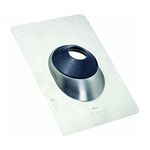
A lot of people think I’m kidding when I sing the praises of shingling a house from the ridge down, but I’m not. Quite to the contrary, shingling a roof from the top down (we’re talking asphalt shingles here) can be faster than going from the eaves up, and it always gives a better roof. For example, starting at the ridge and working down saves you from walking over the materials you just applied. On a hot day, the wear and tear on an asphalt roof can be considerable, especially on light-colored roofing. This factor alone will add a year or two to the life of the roof.
On roofs requiring staging, such as the one shown in the drawing, you can fasten your duckboards and scaffold supports directly to the deck without special brackets, quickly adding whatever staging will speed your work around dormers and the like. Whatever you build will be convenient to remove on your way down, without fear of damaging the roof.
In reroofing there is an additional advantage: Because debris slides down over only the old roof, you can redo only as many courses at a time as you feel comfortable removing. I have reroofed a house during two days of fog, drizzle and the odd shower, thanks to this method.
The trick is to have several starter courses and initially to nail these shingles at the top only. As shown in the drawing, snap a line below the ridge that gives you a comfortable reach. The line should be an exact number of courses from the eave, as defined by the shingle exposure. Now nail your first course of shingles with the lower edges following the line, but tacked along the top only. Shingle upward from this course to the ridge in normal fashion.
Move your staging down, if need be, and snap another line an exact number of courses below your first one, again within a comfortable reach. As you prepare to nail down this second starter course, don’t forget to start with a full tab or a half tab at the rake, depending on whether you have an odd or even number of courses to lay. Shingle upward to the initial starting course, which you will lift out of your way to allow the lower course to tuck under it. With the lower course safely nailed in place, you can now nail the initial starter course of shingles in the normal fashion.
Repeat this sequence as often as necessary to reach the eave. This technique is simpler to do than it is to describe it, and in my experience, shingling from the top down is part of the permanent repertoire of all who try it.
—Emanuel Jannasch, Halifax.
Edited and illustrated by Charles Miller
From Fine Homebuilding #102
Fine Homebuilding Recommended Products
Fine Homebuilding receives a commission for items purchased through links on this site, including Amazon Associates and other affiliate advertising programs.

Roofing Gun

Flashing Boot

Ladder Stand Off



























View Comments
I couldn't agree with you more! Been doing it this way on any roof over a 6/12 pitch for 20 years. Safer, easier, no shingle damage, no straddling the ridge, convenient shingle package placement, the advantages go on and on! Can't believe you don't see it more!
Ditto! Why don't shingle makers even suggest this option?
work great have been doing roofing this way for years not as fast as roof down but gives a better lasting roof and you can do it with one person john runyon old 1145 union carpenter